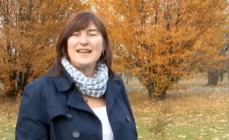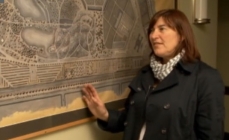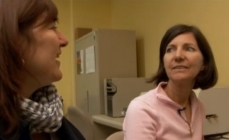Transcription of video clip Behind the Scenes

© Jardin botanique de MontrĂ©al
CĂ©line Arseneault
Hello, my name is CĂ©line Arseneault, I am a botanist at the Botanical Garden, and coordinator of the exhibit Trees Inside Out.
Today, I would like to take you behind the scenes at the Arboretum,
to explain to you what distinguishes an Aboretum from a large, tree-filled park.
To do this, I would like to introduce you to the actors of the Arboretum, those who manage, maintain and interpret the collections. Will you follow me?

© Jardin botanique de MontrĂ©al
An original mal of the Jardin botanique, made by Henri Teuscher
We are in front of the original plan of the Botanical Garden, drawn in 1938 by Henri Teuscher, the first curator of the Garden and a landscape architect.
Since 1931, when the Garden was officially created, trees were gradually planted in the northern portion.
But it was not until 1970 that the northern part of the Arboretum was developed,
thus officially creating the Arboretum in a former quarry.
- Hello Stéphane.
- Hello CĂ©line.
- Stéphane Bailleul, you are the botanist responsible for managing the living plant collections.
- So, it's from the moment a plant is acquired that it becomes part of a collection at the Botanical Garden.
- Yes, CĂ©line, that's right, when a new tree arrives at the Garden, we ensure that the taxon meets our criteria, as defined in our policy for plant acquisition.
For example, we give priority to species over cultivars.
We also prioritize material with known origin in a natural environment, rather than cultivated material.
Also, we want to ensure that when we import trees, we respect Canadian rules and laws.
- When we acquire a plant, how does this happen? How does the Garden obtain these trees?
- Okay, well, there are several ways to obtain trees, for example, in the case of native species,
we generally prefer that it be harvested, either by the seed or by cuttings, directly from the natural environment.
The Garden is also part of a vast network of international seed exchanges,
and this allows us to have access to many species of trees from just about everywhere in the world.

© Jardin botanique de MontrĂ©al
Renée Gaudette, assistant-botanist at the Jardin botanique de Montréal
- OK, now we're going to meet Renée, hello Renée.
- Hello CĂ©line.
- Renée Gaudette, you are an assistant-botanist working with Stéphane's department, and it is your responsibility to document each plant that arrives at the Garden.
- Yes.
So, here, for example, is an ash tree, that comes to us from Germany, so what must be done when our seeds arrive, when little packets of seeds arrive.
We have to register them in our data bank and give them a name.
- A name ?
- That is a number, actually, and this number will follow it, the plant, throughout its life at the Garden.
And, we'll note all sorts of information that has been given to us about this plant,
where it's from, what quantity of it we have
and we'll make labels and tags so this can always be associated with this plant and not be lost.
- So Renée, we have come to the Arboretum, and this tree already has its identification tag,
with its accession number, its inventory number and its Latin name.
But we have to put the label, the tag, so that the public can see it.
- Yes.
- So how is it placed?
- There we go!
- So, now we are at the Arboretum with Michel Guérette, who is the gardener responsible for the Arboretum. Hi Michel.
- Hello CĂ©line.
- Michel, it's your responsibility to plan the development of collections, to know where the trees will be planted,
then to maintain them, prune them. So, tell me, also, how do you decide where you are going to plant a tree?
- Well, the Arboretum is divided into collections, so certainly oaks will go with oaks.
Then we select on the site, we go and look, we know an oak needs good drainage,
so I wouldn't plant it in a depression, so it's small factors like that.
Then, what's important is to ensure that it will have room to grow, without too much human intervention, so that each tree can express its genetics, its form, if it will be globular or slender.
So, that's what determines the choice for planting in the Arboretum.
- Do you plant many trees each year?
- About 150.
- Right.
- Once the inventory labels and identification tags are attached to each tree,
the challenge is also to interpret all the information that exists in the Arboretum.
One way to help visitors discover the immense expanse of the Arboreteum
is to offer them workshops and guided tours that the nature interpretation staff of the Garden as well as the Friends of the Garden provide for visitors.
So, I am with Monique Poissant, who has been a volunteer guide for three years. Hello Monique.
- Hello.
- So what is your greatest motivation in being a guide in the Arboretum?
- The Arboretum is, the challenge is to introduce visitors to half or even a little more than half of the Botanical Garden.
I like to begin by talking about the history of the Arboretum, what the site looked like before, and also presenting little stories about the trees.
So the metasequoia, copper-colored at this time of year, is very beautiful and will lose its needles, its leaves, soon.
I presented it as a fossil tree,
and a visitor who was very interested in fossils who comes to the Garden regularly
because on the low walls of the former quarry, it seems one can find.
- Right.
- Or to present maple sugar to a visitor from abroad, the way their eyes light up.
Back to video clip




